MAN3716 Report: Contemporary Issues in Project Management - Quality
VerifiedAdded on 2023/04/21
|19
|3713
|346
Report
AI Summary
This report provides an analysis of Six Sigma and Lean approaches to quality management, examining their origins, principles, and integration. It explores the Six Sigma methodology, including its DMAIC process and advantages, while also detailing the Lean approach's focus on waste elimination. The report further investigates how these two methodologies can be combined into Lean Six Sigma (LSS) for enhanced quality improvement, referencing various companies and research to support its findings. Criticisms of both approaches are addressed, and the report concludes with key findings on the effectiveness of these methods in improving quality, productivity, and customer satisfaction. Desklib offers this solved assignment and more resources for students.

1
Assessment Task 1 Six sigma lean-innovation
(Insert your name)
Subject
Professor’s name
Date
Assessment Task 1 Six sigma lean-innovation
(Insert your name)
Subject
Professor’s name
Date
Paraphrase This Document
Need a fresh take? Get an instant paraphrase of this document with our AI Paraphraser
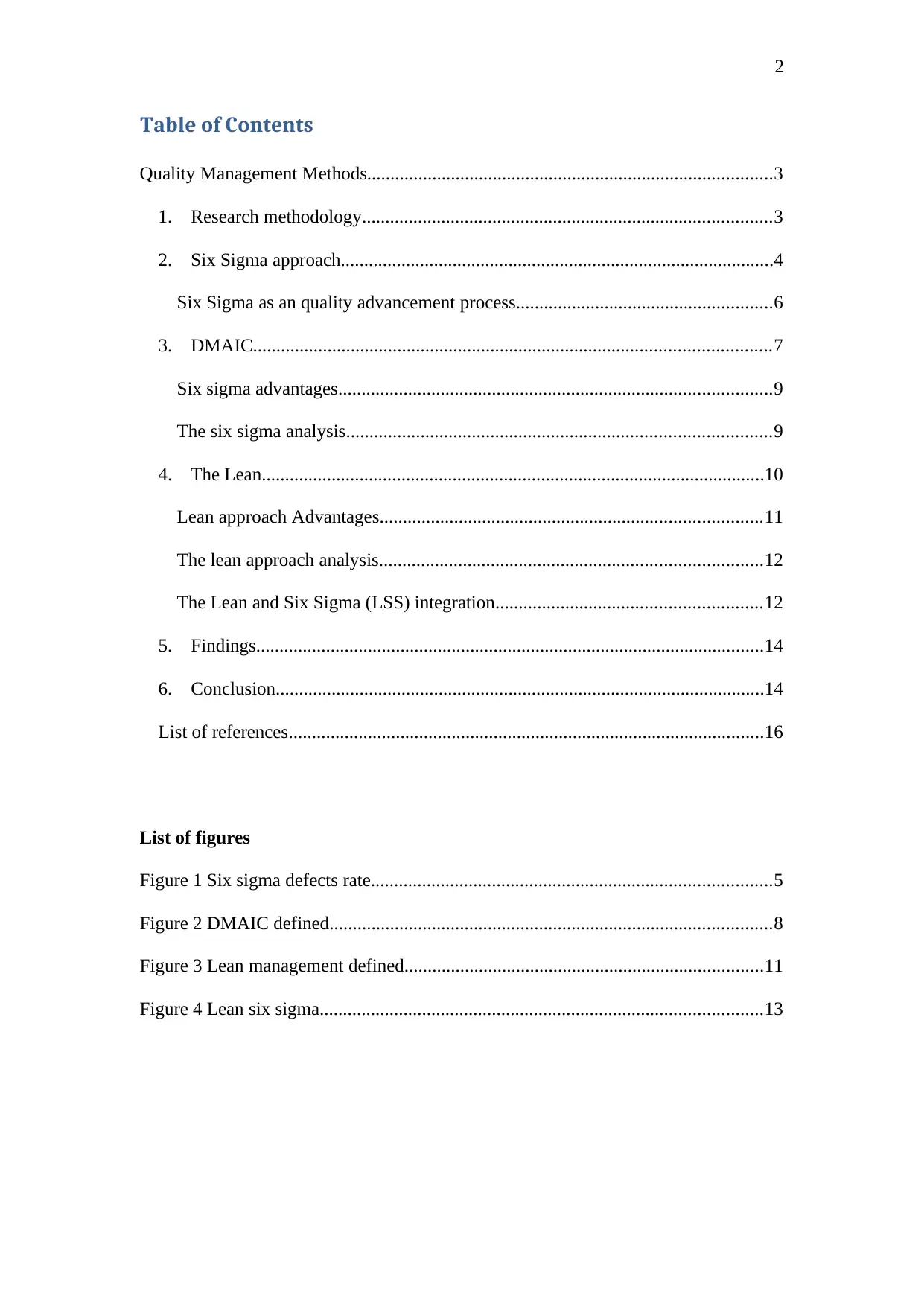
2
Table of Contents
Quality Management Methods.......................................................................................3
1. Research methodology........................................................................................3
2. Six Sigma approach.............................................................................................4
Six Sigma as an quality advancement process.......................................................6
3. DMAIC...............................................................................................................7
Six sigma advantages.............................................................................................9
The six sigma analysis...........................................................................................9
4. The Lean............................................................................................................10
Lean approach Advantages..................................................................................11
The lean approach analysis..................................................................................12
The Lean and Six Sigma (LSS) integration.........................................................12
5. Findings.............................................................................................................14
6. Conclusion.........................................................................................................14
List of references......................................................................................................16
List of figures
Figure 1 Six sigma defects rate......................................................................................5
Figure 2 DMAIC defined...............................................................................................8
Figure 3 Lean management defined.............................................................................11
Figure 4 Lean six sigma...............................................................................................13
Table of Contents
Quality Management Methods.......................................................................................3
1. Research methodology........................................................................................3
2. Six Sigma approach.............................................................................................4
Six Sigma as an quality advancement process.......................................................6
3. DMAIC...............................................................................................................7
Six sigma advantages.............................................................................................9
The six sigma analysis...........................................................................................9
4. The Lean............................................................................................................10
Lean approach Advantages..................................................................................11
The lean approach analysis..................................................................................12
The Lean and Six Sigma (LSS) integration.........................................................12
5. Findings.............................................................................................................14
6. Conclusion.........................................................................................................14
List of references......................................................................................................16
List of figures
Figure 1 Six sigma defects rate......................................................................................5
Figure 2 DMAIC defined...............................................................................................8
Figure 3 Lean management defined.............................................................................11
Figure 4 Lean six sigma...............................................................................................13

3
QUALITY MANAGEMENT METHODS
Different organizations use different approaches in improving quality of its
products. Six sigma and lean approaches are the two major tools used in
improving quality. The basis of the six sigma approach was initiated by
Motorola Company with an objective of minimizing variation in the production
processes while the lean approach was initiated by Toyota Motor Corporation
with an intention of minimizing waste in its production.
The two concepts complement each other. When a company intends to
achieve high quality in production, it must use both approaches. Lean
approach cannot be able to provide the arithmetical command of a procedure
while six sigma does not improve the required pace of the process. According
to Honeywell (2012), “lean and six sigma organizations have some sort of
improvements by implementing the other half”. This gives the lean Six Sigma
(LSS) meaning. The paper analyses the six sigma approaches and the lean
approach by analyzing different companies that uses the two approaches.
1. Research methodology
The procedure and the techniques that were used to recognize, decide
on, process and give the analysis of the different approaches that are used in
quality management process were determined from researching on various
research works on quality management management approaches as well
topics from previous studies. The paper evaluated different sources to come
up with valid and reliable results. In addition, the paper gives a well
researched analysis of the meaning of Lean, Six Sigma and DMAIC
approaches. This gives a clear definition of the three and analyzes their
fundamental importance.
QUALITY MANAGEMENT METHODS
Different organizations use different approaches in improving quality of its
products. Six sigma and lean approaches are the two major tools used in
improving quality. The basis of the six sigma approach was initiated by
Motorola Company with an objective of minimizing variation in the production
processes while the lean approach was initiated by Toyota Motor Corporation
with an intention of minimizing waste in its production.
The two concepts complement each other. When a company intends to
achieve high quality in production, it must use both approaches. Lean
approach cannot be able to provide the arithmetical command of a procedure
while six sigma does not improve the required pace of the process. According
to Honeywell (2012), “lean and six sigma organizations have some sort of
improvements by implementing the other half”. This gives the lean Six Sigma
(LSS) meaning. The paper analyses the six sigma approaches and the lean
approach by analyzing different companies that uses the two approaches.
1. Research methodology
The procedure and the techniques that were used to recognize, decide
on, process and give the analysis of the different approaches that are used in
quality management process were determined from researching on various
research works on quality management management approaches as well
topics from previous studies. The paper evaluated different sources to come
up with valid and reliable results. In addition, the paper gives a well
researched analysis of the meaning of Lean, Six Sigma and DMAIC
approaches. This gives a clear definition of the three and analyzes their
fundamental importance.
⊘ This is a preview!⊘
Do you want full access?
Subscribe today to unlock all pages.

Trusted by 1+ million students worldwide
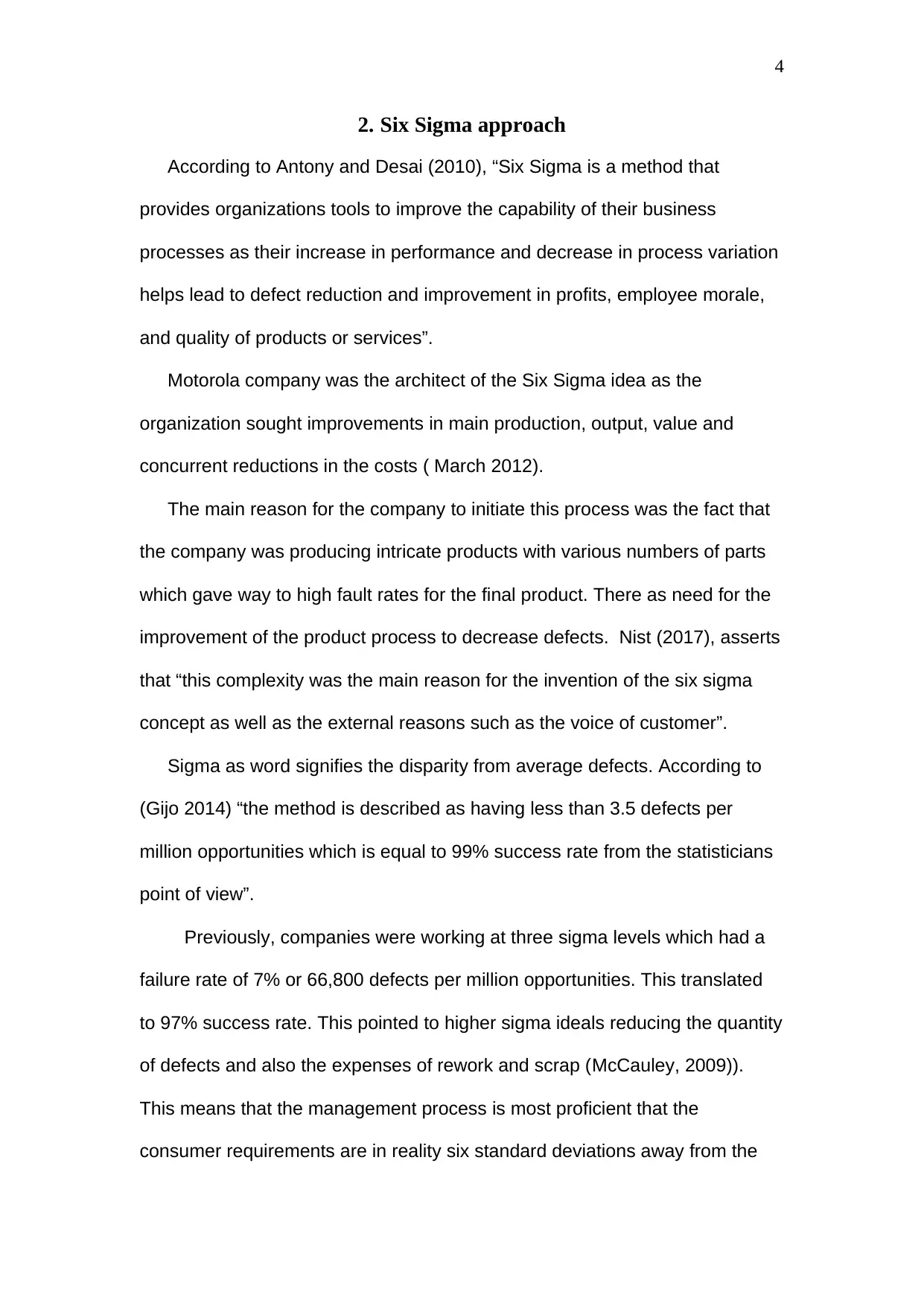
4
2. Six Sigma approach
According to Antony and Desai (2010), “Six Sigma is a method that
provides organizations tools to improve the capability of their business
processes as their increase in performance and decrease in process variation
helps lead to defect reduction and improvement in profits, employee morale,
and quality of products or services”.
Motorola company was the architect of the Six Sigma idea as the
organization sought improvements in main production, output, value and
concurrent reductions in the costs ( March 2012).
The main reason for the company to initiate this process was the fact that
the company was producing intricate products with various numbers of parts
which gave way to high fault rates for the final product. There as need for the
improvement of the product process to decrease defects. Nist (2017), asserts
that “this complexity was the main reason for the invention of the six sigma
concept as well as the external reasons such as the voice of customer”.
Sigma as word signifies the disparity from average defects. According to
(Gijo 2014) “the method is described as having less than 3.5 defects per
million opportunities which is equal to 99% success rate from the statisticians
point of view”.
Previously, companies were working at three sigma levels which had a
failure rate of 7% or 66,800 defects per million opportunities. This translated
to 97% success rate. This pointed to higher sigma ideals reducing the quantity
of defects and also the expenses of rework and scrap (McCauley, 2009)).
This means that the management process is most proficient that the
consumer requirements are in reality six standard deviations away from the
2. Six Sigma approach
According to Antony and Desai (2010), “Six Sigma is a method that
provides organizations tools to improve the capability of their business
processes as their increase in performance and decrease in process variation
helps lead to defect reduction and improvement in profits, employee morale,
and quality of products or services”.
Motorola company was the architect of the Six Sigma idea as the
organization sought improvements in main production, output, value and
concurrent reductions in the costs ( March 2012).
The main reason for the company to initiate this process was the fact that
the company was producing intricate products with various numbers of parts
which gave way to high fault rates for the final product. There as need for the
improvement of the product process to decrease defects. Nist (2017), asserts
that “this complexity was the main reason for the invention of the six sigma
concept as well as the external reasons such as the voice of customer”.
Sigma as word signifies the disparity from average defects. According to
(Gijo 2014) “the method is described as having less than 3.5 defects per
million opportunities which is equal to 99% success rate from the statisticians
point of view”.
Previously, companies were working at three sigma levels which had a
failure rate of 7% or 66,800 defects per million opportunities. This translated
to 97% success rate. This pointed to higher sigma ideals reducing the quantity
of defects and also the expenses of rework and scrap (McCauley, 2009)).
This means that the management process is most proficient that the
consumer requirements are in reality six standard deviations away from the
Paraphrase This Document
Need a fresh take? Get an instant paraphrase of this document with our AI Paraphraser

5
procedure center (see Figure 1) below. As the product s seen to be with
errors, when produced outside of customer provision, a procedure with such a
high potential will almost bring out no errors.
Figure 1 Six sigma defects rate
According to Pande et. al (2011), Six Sigma is more serious method than
the tradition quality management approach methods. From the traditional
business point of view, this is a strategy a strategy that makes operations in
the business to be more efficient and this brings in profitability and
effectiveness in an effort to satisfy the customers’ wishes and prospect.
Six Sigma is a dominant approach which was initiated in an effort to
accelerate enhancement in product, procedure and service quality. Six Sigma
was initiated by the Motorola Company by Bill Smith in the mid 1980s.
The approach in Six Sigma is a step forward in the process of enhancing
process that gives spectacular decrease in errors in any process. This leads
procedure center (see Figure 1) below. As the product s seen to be with
errors, when produced outside of customer provision, a procedure with such a
high potential will almost bring out no errors.
Figure 1 Six sigma defects rate
According to Pande et. al (2011), Six Sigma is more serious method than
the tradition quality management approach methods. From the traditional
business point of view, this is a strategy a strategy that makes operations in
the business to be more efficient and this brings in profitability and
effectiveness in an effort to satisfy the customers’ wishes and prospect.
Six Sigma is a dominant approach which was initiated in an effort to
accelerate enhancement in product, procedure and service quality. Six Sigma
was initiated by the Motorola Company by Bill Smith in the mid 1980s.
The approach in Six Sigma is a step forward in the process of enhancing
process that gives spectacular decrease in errors in any process. This leads

6
to improved process which translates to satisfied customers, increased
productivity and business. This is done by persistently working on reducing
disparity and doing away with waste (Scott 2011).
The procedure has been credited in turning around Motorola as a
company by enabling the company to accomplish high level of quality. The
company was awarded Malcolm Baldrige National Quality Award in 1988 due
its quality achievement.
Over the years, Six Sigma has been the quality management method used
by numerous sectors as it was promoted by widely. According to (Snee,
2010), six sigma was adopted by big businesses and industries in the USA
and later became a global initiative. Sectors such as banking, health,
transportation (airlines) and hospitality industries have implemented the use of
six sigma approach in an effort to enhance quality in their operations. Initially
seen as a manufacturing approach, most organisations have adapted the six
sigma approach (Schroeder et. Al 2018).
Six Sigma as an quality advancement process
Six sigma quality approach is the tools and techniques used in rectifying
and improving issues in the production process (Sarkar, 2014) . This method
is often seen at the approach that merges the set of tools and techniques
together in the production process of an organization. However, different
definitions have come up over the past years which bring out the same
definition.
to improved process which translates to satisfied customers, increased
productivity and business. This is done by persistently working on reducing
disparity and doing away with waste (Scott 2011).
The procedure has been credited in turning around Motorola as a
company by enabling the company to accomplish high level of quality. The
company was awarded Malcolm Baldrige National Quality Award in 1988 due
its quality achievement.
Over the years, Six Sigma has been the quality management method used
by numerous sectors as it was promoted by widely. According to (Snee,
2010), six sigma was adopted by big businesses and industries in the USA
and later became a global initiative. Sectors such as banking, health,
transportation (airlines) and hospitality industries have implemented the use of
six sigma approach in an effort to enhance quality in their operations. Initially
seen as a manufacturing approach, most organisations have adapted the six
sigma approach (Schroeder et. Al 2018).
Six Sigma as an quality advancement process
Six sigma quality approach is the tools and techniques used in rectifying
and improving issues in the production process (Sarkar, 2014) . This method
is often seen at the approach that merges the set of tools and techniques
together in the production process of an organization. However, different
definitions have come up over the past years which bring out the same
definition.
⊘ This is a preview!⊘
Do you want full access?
Subscribe today to unlock all pages.

Trusted by 1+ million students worldwide
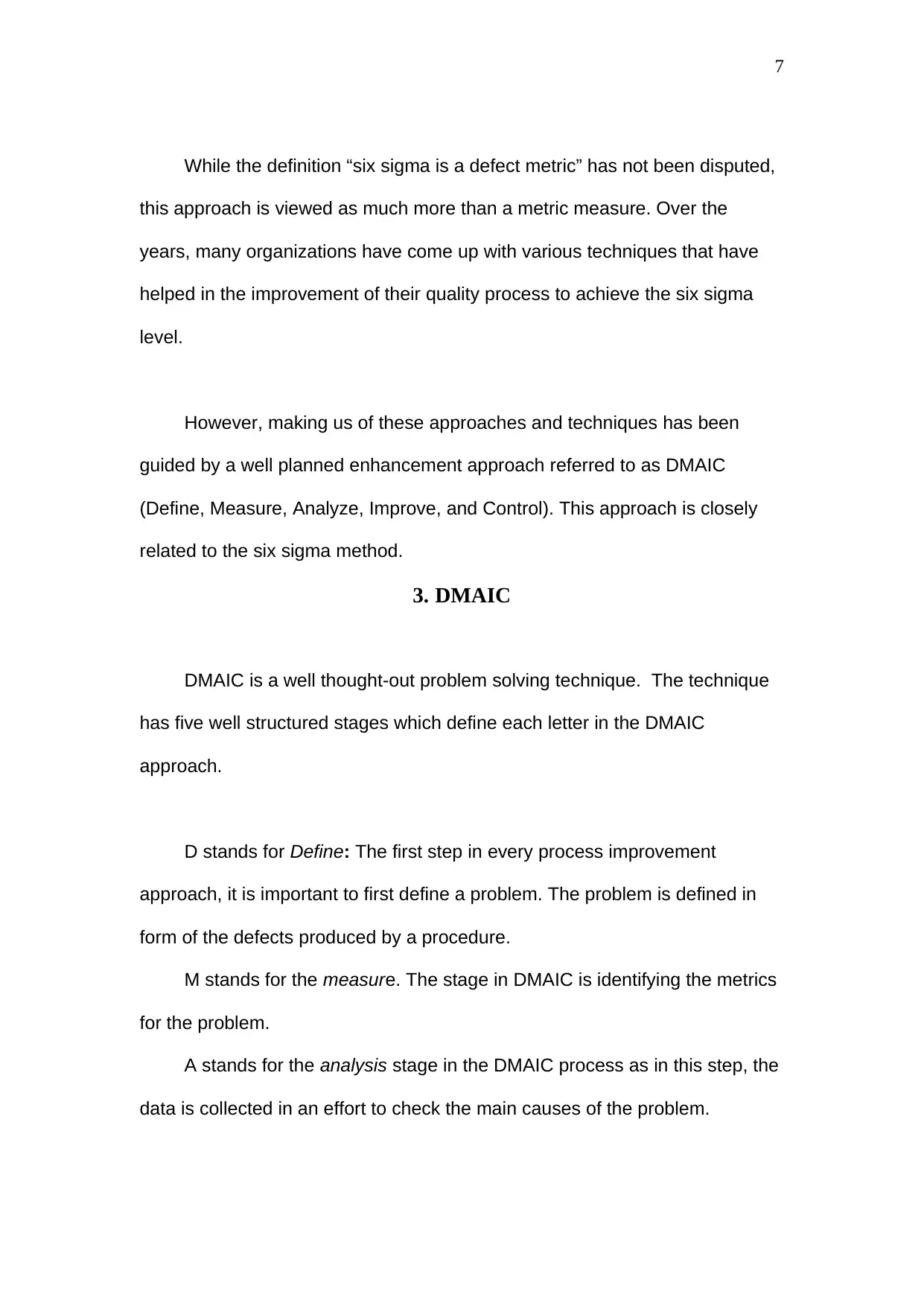
7
While the definition “six sigma is a defect metric” has not been disputed,
this approach is viewed as much more than a metric measure. Over the
years, many organizations have come up with various techniques that have
helped in the improvement of their quality process to achieve the six sigma
level.
However, making us of these approaches and techniques has been
guided by a well planned enhancement approach referred to as DMAIC
(Define, Measure, Analyze, Improve, and Control). This approach is closely
related to the six sigma method.
3. DMAIC
DMAIC is a well thought-out problem solving technique. The technique
has five well structured stages which define each letter in the DMAIC
approach.
D stands for Define: The first step in every process improvement
approach, it is important to first define a problem. The problem is defined in
form of the defects produced by a procedure.
M stands for the measure. The stage in DMAIC is identifying the metrics
for the problem.
A stands for the analysis stage in the DMAIC process as in this step, the
data is collected in an effort to check the main causes of the problem.
While the definition “six sigma is a defect metric” has not been disputed,
this approach is viewed as much more than a metric measure. Over the
years, many organizations have come up with various techniques that have
helped in the improvement of their quality process to achieve the six sigma
level.
However, making us of these approaches and techniques has been
guided by a well planned enhancement approach referred to as DMAIC
(Define, Measure, Analyze, Improve, and Control). This approach is closely
related to the six sigma method.
3. DMAIC
DMAIC is a well thought-out problem solving technique. The technique
has five well structured stages which define each letter in the DMAIC
approach.
D stands for Define: The first step in every process improvement
approach, it is important to first define a problem. The problem is defined in
form of the defects produced by a procedure.
M stands for the measure. The stage in DMAIC is identifying the metrics
for the problem.
A stands for the analysis stage in the DMAIC process as in this step, the
data is collected in an effort to check the main causes of the problem.
Paraphrase This Document
Need a fresh take? Get an instant paraphrase of this document with our AI Paraphraser
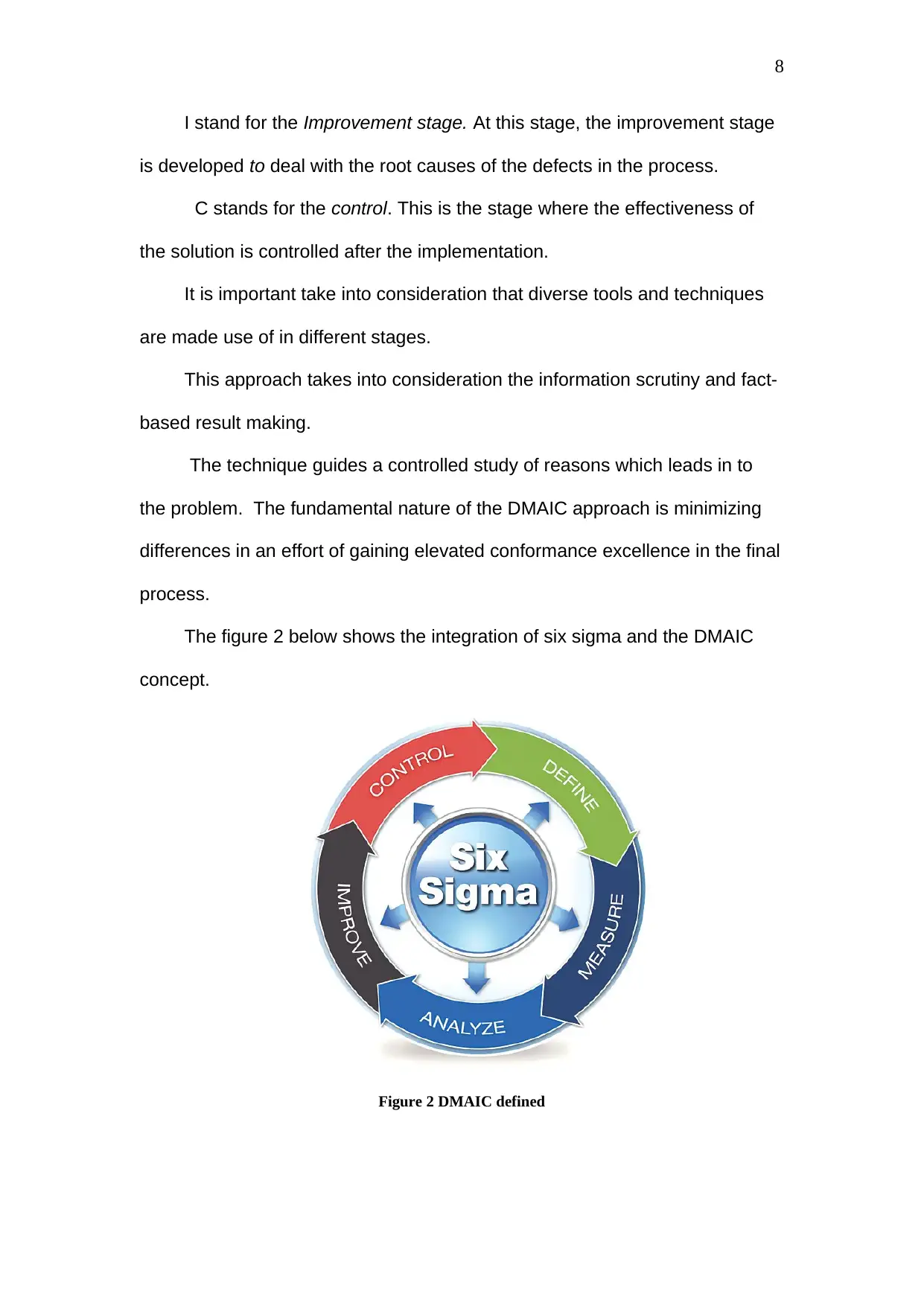
8
I stand for the Improvement stage. At this stage, the improvement stage
is developed to deal with the root causes of the defects in the process.
C stands for the control. This is the stage where the effectiveness of
the solution is controlled after the implementation.
It is important take into consideration that diverse tools and techniques
are made use of in different stages.
This approach takes into consideration the information scrutiny and fact-
based result making.
The technique guides a controlled study of reasons which leads in to
the problem. The fundamental nature of the DMAIC approach is minimizing
differences in an effort of gaining elevated conformance excellence in the final
process.
The figure 2 below shows the integration of six sigma and the DMAIC
concept.
Figure 2 DMAIC defined
I stand for the Improvement stage. At this stage, the improvement stage
is developed to deal with the root causes of the defects in the process.
C stands for the control. This is the stage where the effectiveness of
the solution is controlled after the implementation.
It is important take into consideration that diverse tools and techniques
are made use of in different stages.
This approach takes into consideration the information scrutiny and fact-
based result making.
The technique guides a controlled study of reasons which leads in to
the problem. The fundamental nature of the DMAIC approach is minimizing
differences in an effort of gaining elevated conformance excellence in the final
process.
The figure 2 below shows the integration of six sigma and the DMAIC
concept.
Figure 2 DMAIC defined

9
The tools and the techniques used in Six Sigma are also not exclusive to
the method alone. Most tools and techniques have been seen to be similar to
the tools and the techniques that are seen in a classic Total Quality
Management program. This is in addition to the standard problem solving
tools and techniques. It is more about referring the set of tools and
techniques “Six Sigma”. Moreover, it is viewed as the marketing tool used by
consultants to support the Six Sigma approach
Six sigma advantages
Six sigma performances in the organizations help realize considerable
advantages. When implemented well, the benefits revolve into significant
returns for organizations. The reason for this is that six sigma merges the
process understanding with data, production and project execution
(Siggelkow, 2011). In addition, the organizations that implement Six sigma
approach, discover how to modify their predicaments solving approach from
reactive to practical. According to Strauss and Corbin (2010), six sigma can
be approached from two diverse angles.
The six sigma analysis
According to various researches, six sigma criticisms can be classified into
four parts. The initial analysis on six sigma is that “it is a rename for Total
Quality Management (TQM) (Yin, 2013),”. Research has shown that six sigma
and Total Quality Management have resemblance on issues such as their
center of attention being on their product customer feedback. In addition,
The tools and the techniques used in Six Sigma are also not exclusive to
the method alone. Most tools and techniques have been seen to be similar to
the tools and the techniques that are seen in a classic Total Quality
Management program. This is in addition to the standard problem solving
tools and techniques. It is more about referring the set of tools and
techniques “Six Sigma”. Moreover, it is viewed as the marketing tool used by
consultants to support the Six Sigma approach
Six sigma advantages
Six sigma performances in the organizations help realize considerable
advantages. When implemented well, the benefits revolve into significant
returns for organizations. The reason for this is that six sigma merges the
process understanding with data, production and project execution
(Siggelkow, 2011). In addition, the organizations that implement Six sigma
approach, discover how to modify their predicaments solving approach from
reactive to practical. According to Strauss and Corbin (2010), six sigma can
be approached from two diverse angles.
The six sigma analysis
According to various researches, six sigma criticisms can be classified into
four parts. The initial analysis on six sigma is that “it is a rename for Total
Quality Management (TQM) (Yin, 2013),”. Research has shown that six sigma
and Total Quality Management have resemblance on issues such as their
center of attention being on their product customer feedback. In addition,
⊘ This is a preview!⊘
Do you want full access?
Subscribe today to unlock all pages.

Trusted by 1+ million students worldwide
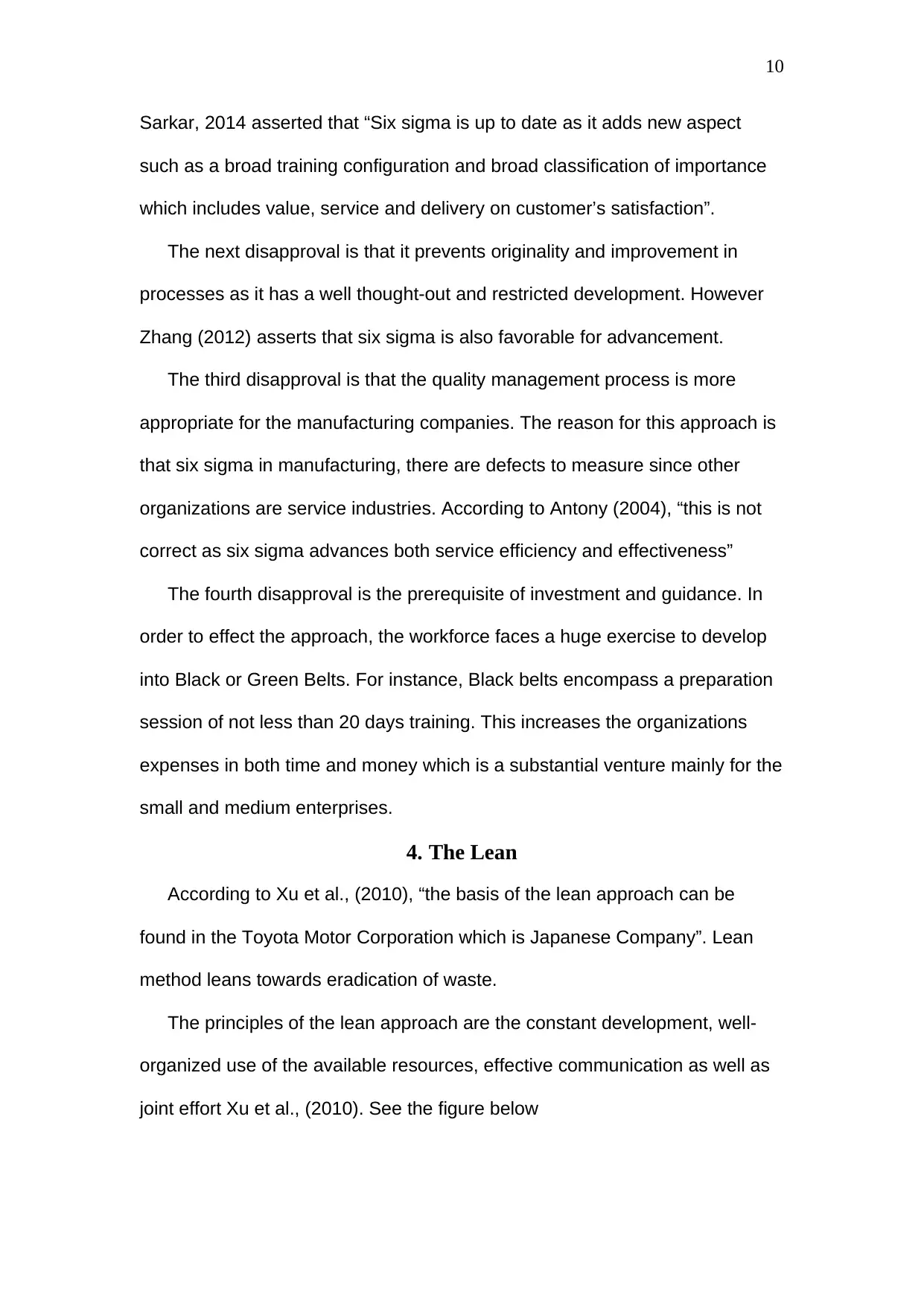
10
Sarkar, 2014 asserted that “Six sigma is up to date as it adds new aspect
such as a broad training configuration and broad classification of importance
which includes value, service and delivery on customer’s satisfaction”.
The next disapproval is that it prevents originality and improvement in
processes as it has a well thought-out and restricted development. However
Zhang (2012) asserts that six sigma is also favorable for advancement.
The third disapproval is that the quality management process is more
appropriate for the manufacturing companies. The reason for this approach is
that six sigma in manufacturing, there are defects to measure since other
organizations are service industries. According to Antony (2004), “this is not
correct as six sigma advances both service efficiency and effectiveness”
The fourth disapproval is the prerequisite of investment and guidance. In
order to effect the approach, the workforce faces a huge exercise to develop
into Black or Green Belts. For instance, Black belts encompass a preparation
session of not less than 20 days training. This increases the organizations
expenses in both time and money which is a substantial venture mainly for the
small and medium enterprises.
4. The Lean
According to Xu et al., (2010), “the basis of the lean approach can be
found in the Toyota Motor Corporation which is Japanese Company”. Lean
method leans towards eradication of waste.
The principles of the lean approach are the constant development, well-
organized use of the available resources, effective communication as well as
joint effort Xu et al., (2010). See the figure below
Sarkar, 2014 asserted that “Six sigma is up to date as it adds new aspect
such as a broad training configuration and broad classification of importance
which includes value, service and delivery on customer’s satisfaction”.
The next disapproval is that it prevents originality and improvement in
processes as it has a well thought-out and restricted development. However
Zhang (2012) asserts that six sigma is also favorable for advancement.
The third disapproval is that the quality management process is more
appropriate for the manufacturing companies. The reason for this approach is
that six sigma in manufacturing, there are defects to measure since other
organizations are service industries. According to Antony (2004), “this is not
correct as six sigma advances both service efficiency and effectiveness”
The fourth disapproval is the prerequisite of investment and guidance. In
order to effect the approach, the workforce faces a huge exercise to develop
into Black or Green Belts. For instance, Black belts encompass a preparation
session of not less than 20 days training. This increases the organizations
expenses in both time and money which is a substantial venture mainly for the
small and medium enterprises.
4. The Lean
According to Xu et al., (2010), “the basis of the lean approach can be
found in the Toyota Motor Corporation which is Japanese Company”. Lean
method leans towards eradication of waste.
The principles of the lean approach are the constant development, well-
organized use of the available resources, effective communication as well as
joint effort Xu et al., (2010). See the figure below
Paraphrase This Document
Need a fresh take? Get an instant paraphrase of this document with our AI Paraphraser
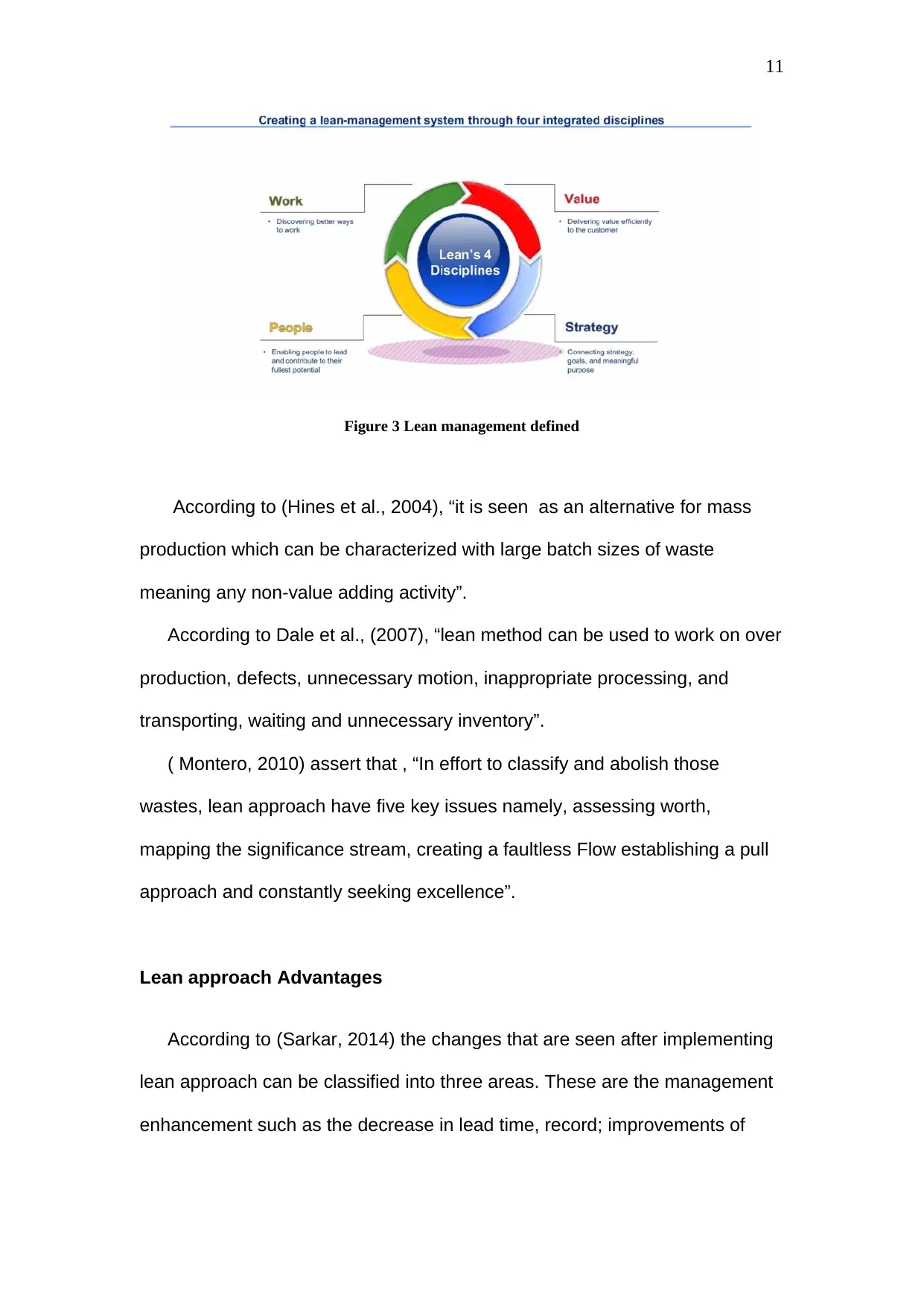
11
Figure 3 Lean management defined
According to (Hines et al., 2004), “it is seen as an alternative for mass
production which can be characterized with large batch sizes of waste
meaning any non-value adding activity”.
According to Dale et al., (2007), “lean method can be used to work on over
production, defects, unnecessary motion, inappropriate processing, and
transporting, waiting and unnecessary inventory”.
( Montero, 2010) assert that , “In effort to classify and abolish those
wastes, lean approach have five key issues namely, assessing worth,
mapping the significance stream, creating a faultless Flow establishing a pull
approach and constantly seeking excellence”.
Lean approach Advantages
According to (Sarkar, 2014) the changes that are seen after implementing
lean approach can be classified into three areas. These are the management
enhancement such as the decrease in lead time, record; improvements of
Figure 3 Lean management defined
According to (Hines et al., 2004), “it is seen as an alternative for mass
production which can be characterized with large batch sizes of waste
meaning any non-value adding activity”.
According to Dale et al., (2007), “lean method can be used to work on over
production, defects, unnecessary motion, inappropriate processing, and
transporting, waiting and unnecessary inventory”.
( Montero, 2010) assert that , “In effort to classify and abolish those
wastes, lean approach have five key issues namely, assessing worth,
mapping the significance stream, creating a faultless Flow establishing a pull
approach and constantly seeking excellence”.
Lean approach Advantages
According to (Sarkar, 2014) the changes that are seen after implementing
lean approach can be classified into three areas. These are the management
enhancement such as the decrease in lead time, record; improvements of

12
managerial operations; and calculated enhancement such as decreased
expenses.
The lean approach analysis
The general analysis of the lean approach is that it cannot work with
vibrant conditions. Lean method requires a steady atmosphere in an effort to
take full advantage of scale competence (Anderson et al., 2006).
According to Hines et al., (2004) “The other lean criticism is about the
human aspect whereby Lean system can be viewed as manipulative and the
rationale for high anxiety on the shop floor employees”. However, the constant
changes on the process can be taxing and employees may demand going
back to the initial way of doing things.
It is therefore probable to conclude that lean and six sigma approaches
have both merits and demerits which can also bring about similarities and
differences between the two approaches.
The Lean and Six Sigma (LSS) integration
As discussed above, lean approach focuses on manufactured goods flow
and eradication of waste, whereas six sigma objectives are to reduce
inconsistency. According to Maniago et. Al (2013), “using either one of the
philosophies in isolation may create diminishing returns at some point, as the
combination of both may bring improvements in productivity since Lean Six
Sigma (LSS) aims to capitalize the strengths of the two philosophies and
avoid the weaknesses of them”. The figure below explains further.
managerial operations; and calculated enhancement such as decreased
expenses.
The lean approach analysis
The general analysis of the lean approach is that it cannot work with
vibrant conditions. Lean method requires a steady atmosphere in an effort to
take full advantage of scale competence (Anderson et al., 2006).
According to Hines et al., (2004) “The other lean criticism is about the
human aspect whereby Lean system can be viewed as manipulative and the
rationale for high anxiety on the shop floor employees”. However, the constant
changes on the process can be taxing and employees may demand going
back to the initial way of doing things.
It is therefore probable to conclude that lean and six sigma approaches
have both merits and demerits which can also bring about similarities and
differences between the two approaches.
The Lean and Six Sigma (LSS) integration
As discussed above, lean approach focuses on manufactured goods flow
and eradication of waste, whereas six sigma objectives are to reduce
inconsistency. According to Maniago et. Al (2013), “using either one of the
philosophies in isolation may create diminishing returns at some point, as the
combination of both may bring improvements in productivity since Lean Six
Sigma (LSS) aims to capitalize the strengths of the two philosophies and
avoid the weaknesses of them”. The figure below explains further.
⊘ This is a preview!⊘
Do you want full access?
Subscribe today to unlock all pages.

Trusted by 1+ million students worldwide
1 out of 19
Related Documents
Your All-in-One AI-Powered Toolkit for Academic Success.
+13062052269
info@desklib.com
Available 24*7 on WhatsApp / Email
![[object Object]](/_next/static/media/star-bottom.7253800d.svg)
Unlock your academic potential
Copyright © 2020–2025 A2Z Services. All Rights Reserved. Developed and managed by ZUCOL.





